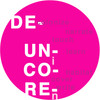In-between Spaces. Repairing and Motion
spotting and inhabiting cracks for living in hostile environments:
a few practical tips for those in need
- Unlearning Central Asia: A Reparative Essay
- Why Central Asia
- Why Reparative and not Decolonial, what is ‘reparative’?
- “If they don’t give you a seat at the table, bring a folding chair.”
- The Invisible 130
- Reparative cooking
- Decolonization did not Happen
- In-between Spaces
- Nepantla space and nepantleras-bridges living there
- A space of intersectionality, multiplicity, and difference
- A space to move as largely and as freely as possible, as a witness
- Body is a public spectacle
- Inflamed Recreation Room
I’m half unseen,
to me, my skin
a screen
to all within.
My eyes can see a star,
but not my mind.
The more I think,
the more I am unfamiliar.
Insight is half blind
and surface-bounded.
Where is my core?
What inwardnesses are
unseen, unsounded?
—Outsight, Ursula K. Le Guin
Olga Mun, researcher and activist, joined the residencies by a happy coincidence. The de_colonialanguage collective did an Open Call, and Olga sent in her idea for what could be done at the Open Air Museum of Decoloniality. It was a very intense and fulfilling residency in August this year. It was more like a long walk with an old friend whom we hadn’t seen in a long time. A very generous space for exchange and insights (or outsights?)
We decided to work nearby the Friendship of Nations fountain (Brunnen der Völkerfreundschaft) at the Open Air Museum of Decoloniality, Alexanderplatz, Berlin. The issue of minorities, who are not given a voice in centralized narratives, was of utmost importance to us. And this fountain is a symbol of the Soviet ideology of Дружба Народов (eng. Friendship of Nations), which is characterized by the silencing of minority voices, renaming them, erasing their languages, assimilation, and other violent colonial mechanisms. It was very meaningful for us to find our strength and voice in this particular place. We chose the healing focus—reparation despite everything.
It would be enough for you to pass by these words
for the phoenix to find its image in us, and for
the spirit born of spirit to be born of flesh.
—Mahmoud Darwish, The Seven Days of Love
We decided to encourage people to talk about their pain amid the cacophony of the commercial, transport, and public square, in the hope that simply voicing their pain would pave the way for repairing. When we arrived at Alexanderplatz, we discovered that the space around the fountain was completely occupied by a private fashion show. We decided that we had no way of separating the reparative session from the Fountain of Friendship of Nations. We stood in the center of the crowd and invited everyone to talk about their pain.
As in nonplaces (Augé, 1995), an intimate space for one-to-one conversation appeared in the crowd, which no one but the two people involved could hear, despite the active presence of the crowd around them. People were taking a seat, sharing, and recounting their intimate experiences. Olga wrote everything down and gave everyone who shared a bottari as a promise that healing is possible.

I would call the space we created together in the center of the cacophony an in-between space. Its legal status is suspended. The regulations are unclear, and different actors perceive and use it simultaneously and in very different ways. Right in the middle of one of the reparative sessions, two men from private security approached us and said that Alexanderplatz now belonged to a private individual who had bought the space for a private fashion show, and therefore we had to leave the public-now-private space. We insisted that this nonplace is an in-between space and that there is room here for us and many others who do not fit into private formats. We managed to defend our right to be present and to act there.
The next day, we put all the pain collected on the square into the Signal Window and held a collective session of reparative cooking. It was togetherness that was our main remedy for a multitude of pains and experiences. Togetherness in listening, in finding a place to speak, to be, in moving further.
Unlearning Central Asia:
A Reparative Essay
Olga Mun, Oxford University
Why Central Asia
I have been dreaming about the issues of national identity before I was born. The memories of the displacement, movement and belonging imprinted in my and my family’s DNA. The stories told, the stories forgotten and unknown, all making up my family history with narratives, silences and gaps.
When I became an academic and professional writer, I started researching the issues of national identity and belonging in the education and school curriculum of Kazakhstan. The results of two master’s degrees and two theses was that in post-independent Kazakhstan, ethnic minorities like Koreans, were reduced to tokenistic stories about one off celebrations of diversity. It is usually thought that such lack of representation of ethnic diversity in independent Central Asia is a result of the Soviet legacy, but is it? To what extent the independent nations can take credit for any positive notions of ‘development’, whilst any exclusionary discourses are framed as ‘Soviet legacy’? The practices and narratives of exclusion based on ethnicity and gender have shaped my life as an ethnic minority in Kazakhstan. So, when I learnt about decolonisation, epistemic injustice and anti-imperial epistemologies, I was keen to problematise such ethnic exclusions by nation-states, without linking the injustices to only the ‘Soviet legacy’, which indeed is one factor shaping such processes, but if we take the agency of local actors seriously, both negative, positive and neutral agency must be taken into account. That is how my journey of unlearning nationalistic visions of Central Asia began, shaped by myths spread in the national curricula, everyday practices and beyond.
I, of course, in this essay can cite many scholars, artists, painters, musicians and thinkers who write globally on the issues of decolonisation, belonging and unlearning modernity. As a trained scholar in an elite context of British academia, I know very well how to write traditional literature reviews. However, in this essay, which is more of a personal reflection, I have decided not to cite written texts but instead to honor the oral traditions of Kazakh and Korean cultures, and cite stories, dialogues, songs and art.
Why Reparative and not Decolonial, what is ‘reparative’?
As I enthusiastically joined the decolonial discussions in Central Asia and in Britain, I was so happy to share my research outputs on epistemic injustice and the experience of Central Asian scholars in Britain. I published, I gave TedX talks in Central Asia, I prioritized speaking in Central Asia based universities to share my knowledge. I thought that decolonial academics and practitioners are inclusive and would most certainly be different from the typical neoliberal scholars who prioritise individual writing and careerism over collective community projects to build the world free of intersecting racial and gender oppressions. Whilst it would be unscholarly to make oversimplified generalisations, to my regret I found that many decolonial narratives focus on ethnic visions of the futures and rarely highlight the worldviews of Central Asia, for example, that would be different than building it in a postcolonial way that centers titular ethnicities. For now, this is the main reason for me intellectually to distance myself from the ‘decolonial bandwagon’ (Moosavi, 2020), which is this assumption that decoloniality is a trend for careerism, rather than a genuine praxis of care and radical more inclusive reimagination of the world. In my vision reparative approaches move beyond empty promises, co-optation and careerism that unfortunately penetrated decolonial discussions, with elite and VIP invitation-only decolonial forums held in English language at elite universities, with no voices from the Global Majority contexts in sight…
“If they don’t give you a seat at the table, bring a folding chair.”
I think about the phrase by Shirley Chisholm often. How am I humbly helping to build a reparative academia? I am not perfect indeed and am work-in-progress. But I do think that actions speak louder than words and I try to physically make Oxford more inclusive by organising pluriversal events, publishing to center diverse epistemologies and citing inclusively. A colleague recently told me, I am not only bringing a chair for myself, I am bringing a bus of diverse voices with me. I was happy to hear such feedback, it was about a climate symposium I am co-leading with friends.
The symposium Learning and Making: Weaving Climate, Water, Land, and Communities (Oxford, 2025) foregrounded the interlacing of craft, ecology, and relational learning. Framed through tactile engagement with weaving, the gathering became a microcosm of reparative pedagogy — a space where climate, water, and land were not abstract themes but material participants. The act of weaving articulated a methodology of connection: threads as rivers, textures as terrains, knots as histories of belonging and dispossession. Within this shared making, participants rehearsed forms of situated knowledge that resist extractivist logics, envisioning community, care, and ecological attunement as intertwined pedagogical practices .
The Invisible 130
The reason I organised a symposium on climate described above is that I was inspired by a decolonial art project ‘The Invisible 130’ that I was lucky to co-lead with Denis and Marina (de_colonialanguage). The goal of the art intervention was to highlight the marginalisation of the knowledges of the ethnic minority groups that reside in Kazakhstan. In Central Asia, the popular narrative maintains that the community is diverse and inclusive, as it is celebrated publicly on a National Unity Day. However, when academics, artists and activists look more closely into school curriculum representation, it is usually the traditions and culture of the main ethnic group that is represented. Similarly decolonial discussions, while rightly reviving the forgotten nomadic knowledges of Central Asia, do not engage with the proverbs, songs, art and culture of the minoritised groups, such as Koreans, to name a few.
When I started planning a performance and an exhibition for the Berlin residency, I was ambitious. I thought I would find the knowledge and the phrases based on 130 ethnic groups that reside in Kazakhstan. The task was impossible for one person to achieve in a month or even several years. My own ignorance was striking: I was completely unaware of the cultures and traditions, languages and art of the 130 ethnic groups that only reside in Kazakhstan and not even the whole space of Central Asia.
Rather than attempting to address all 130 ethnic groups and their complex, hybrid cultures, I chose instead to focus on an interactive performance centered on the Korean concept of bottari. Bottari in Korean language refers to a bundle, it is a form of a textile based bundle that you would pack your most precious belongings during migration or relocation. As Korea was impacted by imperial dominance and wars, dislocation and relocation of people, using the bottari bundles is well-studied. However, for the Koreans of Kazakhstan, who were both deprived of speaking their language in the Soviet and post-Soviet times, many of the Korean cultural practices are still unknown.
For the performance that took place at the Alexanderplatz, together with new friends in Berlin, we have made small bottaris from the recycled polka dot fabric. In each bottari I/we placed a piece of a stone that I collected on a beach in Malaga, Spain. The philosophy of the placing of a stone was to signify the weight of physical trauma and emotional pain we carry with ourselves during the moment of both voluntary and forced displacement.
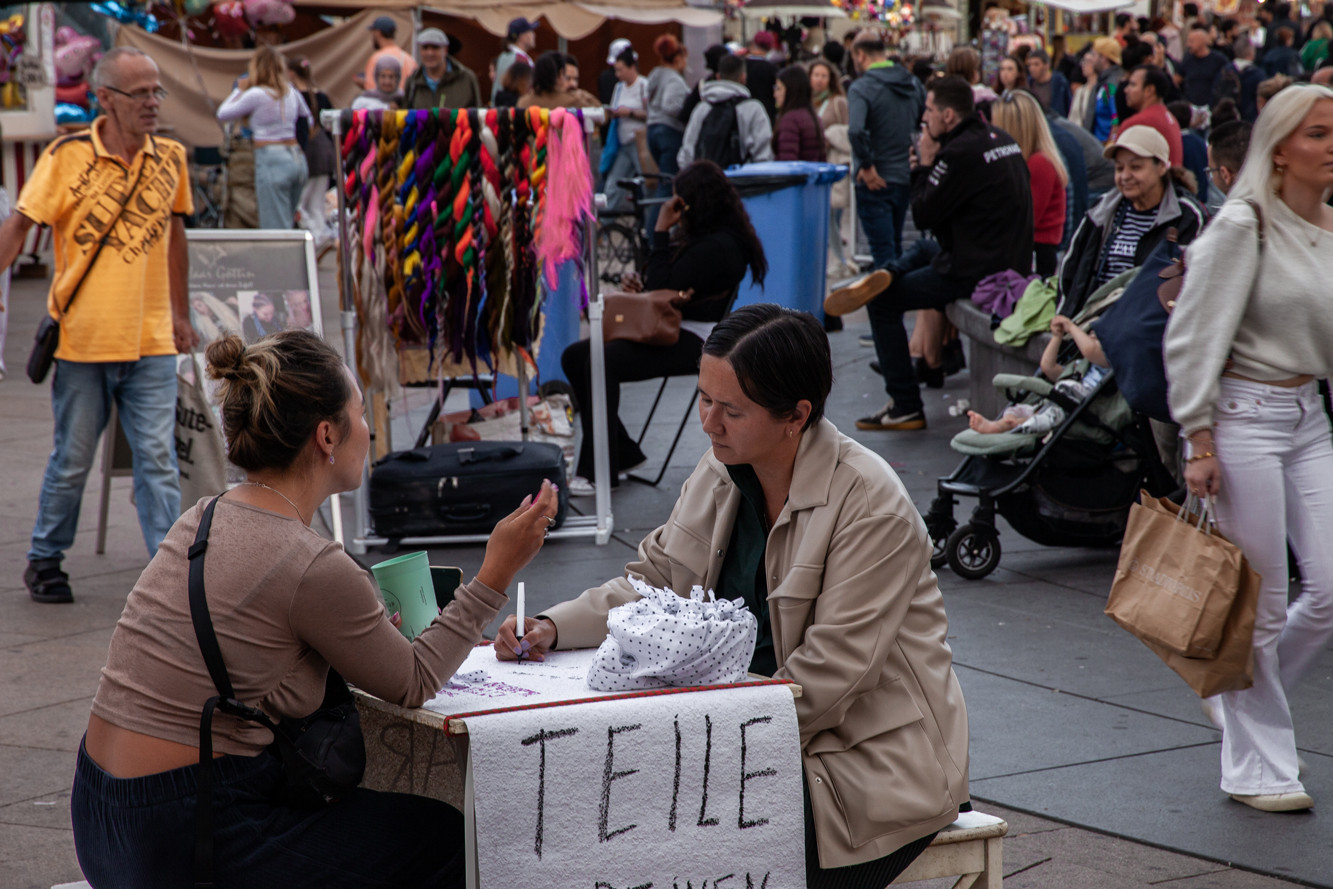
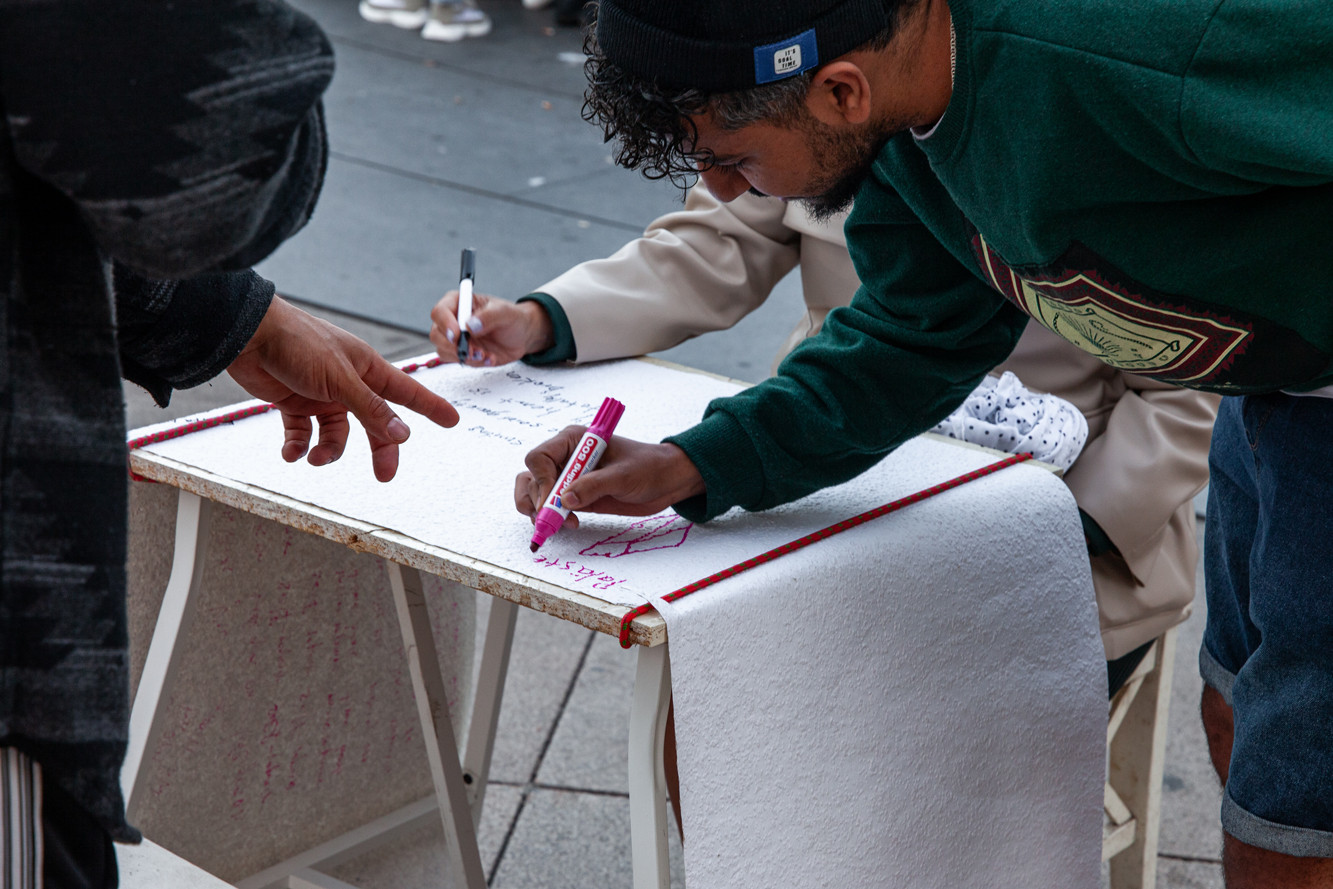
During the performance, the idea was to have a Reparative Session to collect stories of pain the members of the public carry with themselves. In return to the acknowledgement of the shared pain, I, in silence, have given the fellow performers and audience members a bottari. Together with the participants, fully voluntary, we all wrote down our reflections of the pain we carry. I was hoping that such a performance might have a healing and reparative effect on both myself and the participants, as to collectively show we all carry pain and this pain is seen and acknowledged, collectively, we are not alone.
Such a performance and artistic intervention brought unexpected conclusions. Whilst I anticipated the participants to share their reflections on commonly discussed issues of institutional exclusions in the academy, such as racism and sexism, for example, the majority of the participants shared their very personal micro-stories. Some were about a recent heartbreak, a broken family relationship, a miscarriage. Most participants were women, with a few men writing solidarity words with Palestine on a collective piece of paper, which was used as a canvas to write on during a performance.
At the end of the performance that lasted for several hours, we reflected on the pain we carry in Georgian, English, German and other languages. I am grateful to Marina, Denis, new friends and audience members for sharing their pain, thinking about the ways to repair it and hopefully learning about Korean cultural practices of bottari. The response of one member was very touching, as I saw tears in her eyes, when she reflected on her experience of migration and belonging. Upon receiving a bottari, a smile was seen on the corners of her face, and I hope she had a better evening that day, to have known she is not alone in her feelings.
Reparative cooking
I wish I had more space and time to write detailed reflections about the experience and the residency, however this week I had to prioritise paid work and urgent deadlines. That said, I wanted to share a last reflection on what happened the day after the performance on Alexanderplatz. A decolonial fellowship consisted of two parts: a performance and an exhibit. After the reparative performance was over, we had a joint cooking session at the Chto Delat emergency project room. When I was asked to cook a traditional dish, I was a bit puzzled. What is a ‘tradition’ and what is ‘an ethnic dish’? I grew up in the 90’s and we ate instant noodles and bean soups. Whilst I had a happy childhood, my mom prioritised academic writing over home cooking, so as a child after school, when my dad picked me up, we usually collected grilled chicken or snacks from a grocery store. Indeed, a lack of the continued legacy and history of familial recipes is no accident. Whilst in Kazakh culture, the oral traditions preserved many stories of 7 generations, in many non-Kazakh families, the oral archives are different, and, potentially, fewer.
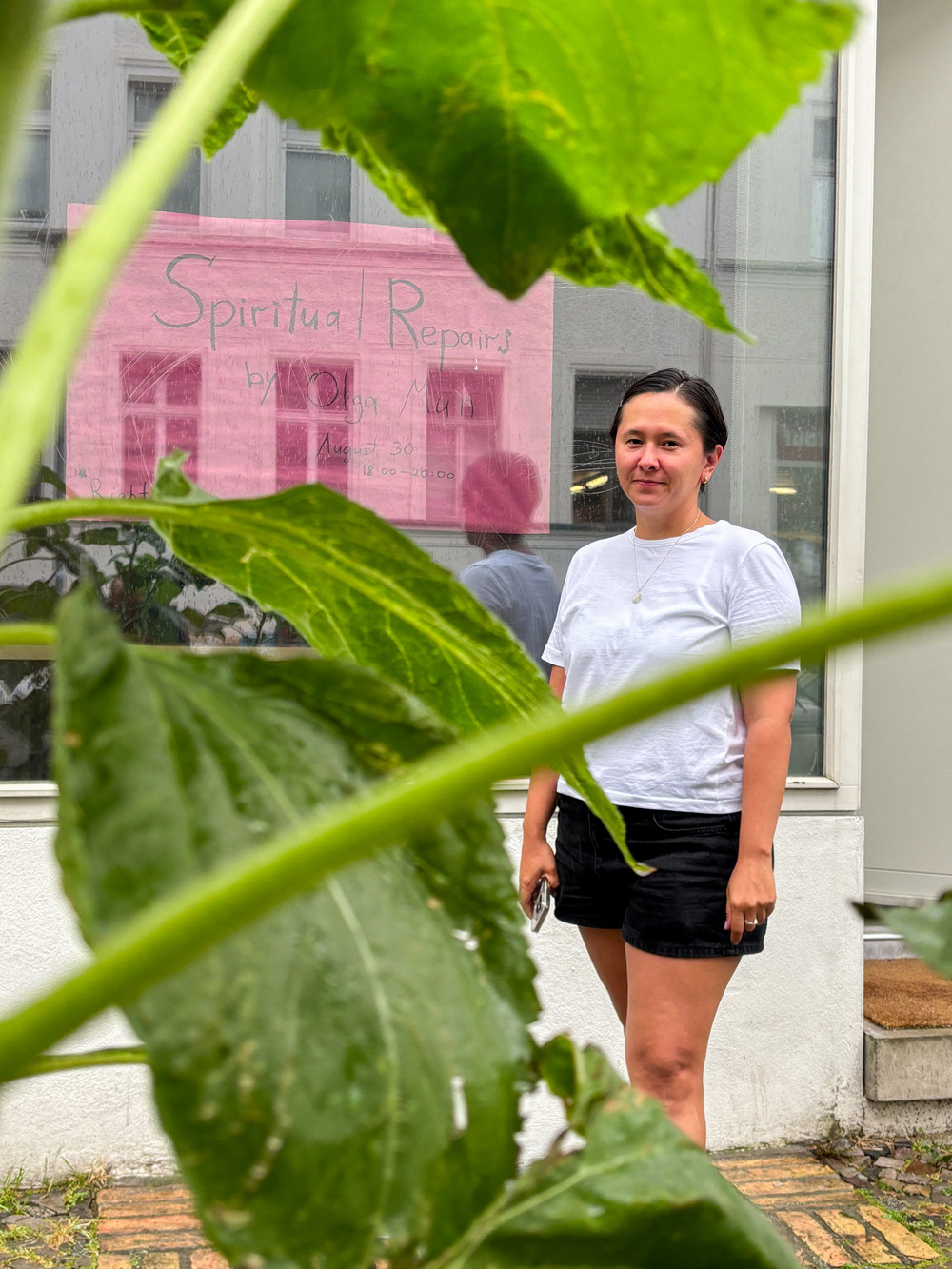
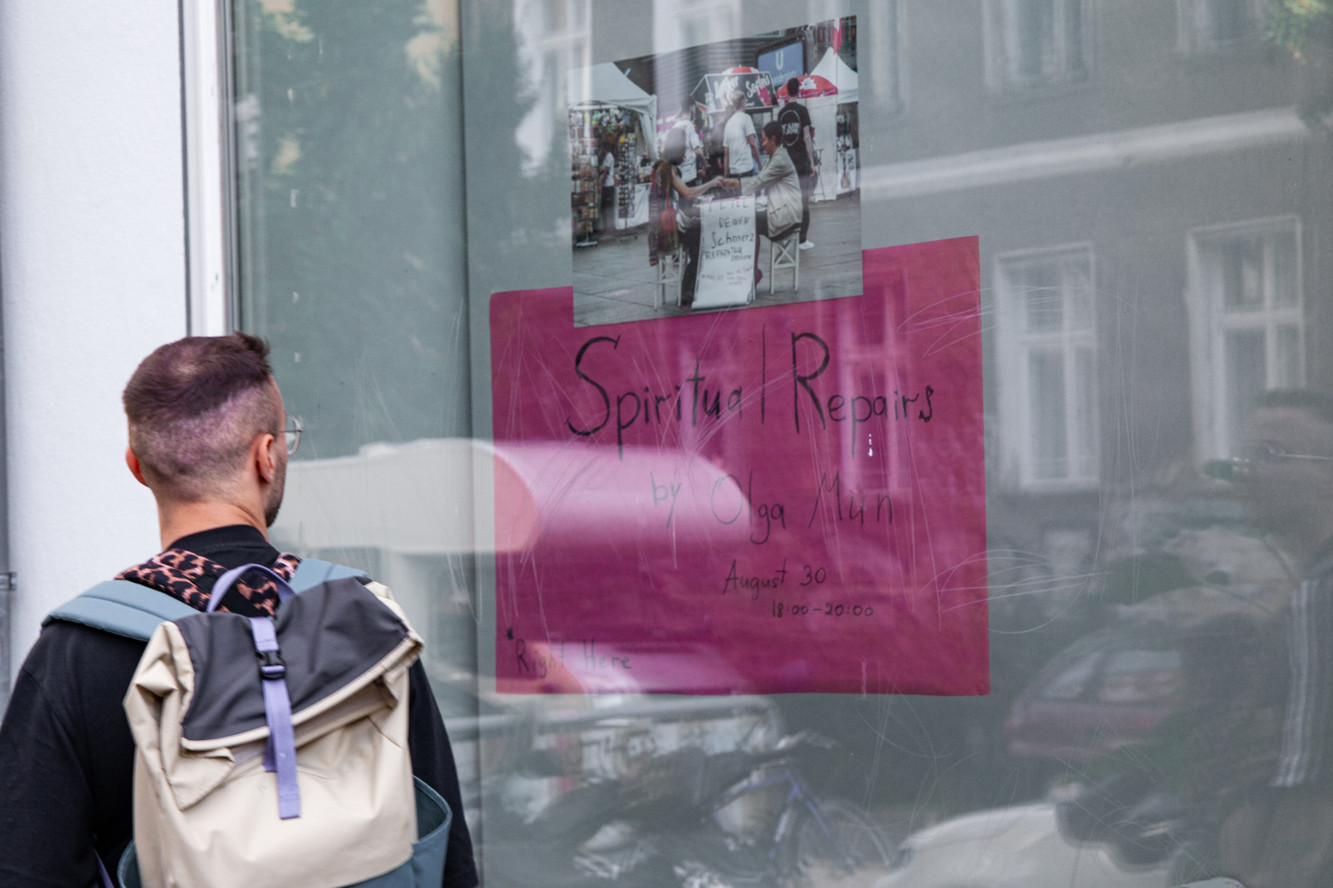
To make a dish I have read a few books on Korean cooking. I have never cooked those dishes myself, but I decided to try reparative cooking, re-connecting to my Korean heritage and cook kim-chi stew with rice. With the luck from the heavens, a Korean artist Kim Hyonsoo was displaying her artwork at a gallery nearby and helped me to cook the Korean dish.
To say I was overjoyed to learn from her is to say nothing. I never had a chance to cook with Korean or Russian grandmothers. At that moment of collective cooking and eating, I realized the power of the community. To have someone who can help you, to listen to you is to me about being reparative. It is not for criticizing for the sake of being critical, it’s not about intellectualizing traumas for careerism, it is about quiet moments of listening to each other’s stories and about sharing a warm meal together. For that, I am grateful to Marina, Denis and the community. For their true decolonial spirit of solidarity, collective emotional, physical and artistic labour. For their reparative spirit and souls.
Such solidarity and spirit of togetherness is to me what being Central Asian. I wish to unlearn the categories of ethnicities imposed on us by the imperial projects, reinforced by the nation-states. In Central Asia there are communities of care, called mahallas. I think I found one such community in Berlin.
Author’s note: grammar editing of the parts of this text was assisted by a AI
Bibliography:
Family stories, secrets and silences,
Olga’s creativity,
Social media stories and projects,
Kazakh traditional wisdom,
Discussions with family and friends, and most specifically with JC Candanedo,
Moosavi, L. (2020). The decolonial bandwagon and the dangers of intellectual decolonisation. Interventions: International Journal of Postcolonial Studies, 22(4), 594–613.
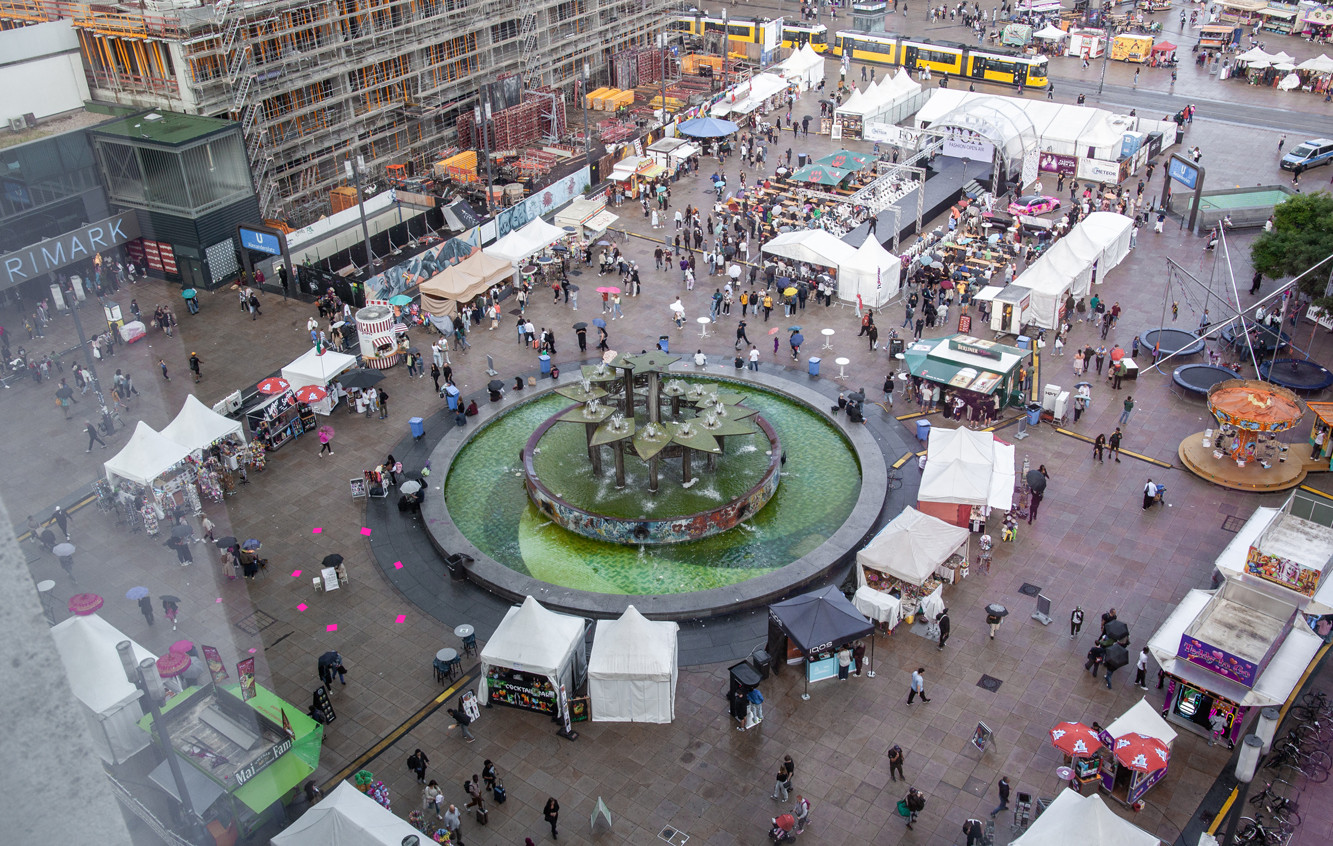
It is important to look around and notice the context in which reparative sessions take place and in-between spaces appear.
Decolonization did not Happen
Denis Esakov, de_colonialanguage
This phrase was uttered by participants at a conference dedicated to the centenary of Frantz Fanon in Sousse, Tunisia. It is written and repeated by Nandita Sharma. It is also repeated by researchers from Central and North Asia and the Caucasus. Decolonization, manifested by Stalin in 1917 and theorized by Lenin, did not happen in the Soviet Union either. By 1933, Stalin had transformed himself to a tyrant and used deportations, Russification, and other colonial methods to consolidate his power under "anti-imperial" fake slogans. This legacy is still part of everyday life in the colonial Russian Federation.
At the very moment when some empires are slipping out of the ethical grip of responsibility for colonial crimes, when the colonized suddenly become migrants (Sharma, 2020), a political space in-between is forming, or what Gloria Anzaldúa called Borderlands/La Frontera. “Moment” sounds ironic, because it took more than a century. This transition from several empires to a multitude of nation states in the postcolonial world order (Sharma, 2020) did not happen. This was a way of changing the power balance from the old Congo-Conference-empires to Bretton-Woods-neocolonialism—the violence of capitalist markets, trade wars, the international debt trap, new colonial settler states (Israel). The postcolonial condition is a tricky invention of imperialism. Actually this is continiung development of the colonial condition, but not the end of colonialism. Decolonization didn’t happen, power relations didn’t change, but they did modified.
When it comes to the driving forces behind postcolonialism, we can narrow it down to two names: Hitler and Roosevelt. This is certainly not a historical narration of events. It is a highly simplified metaphor to help us understand the question, “What is wrong with postcolonialism?” Postcolonialist "Hitler", as a military and fascist phenomenon consisting of many actors, creates a situation in which empires clashed with each other.
And then one fine day the bourgeoisie is awakened by a terrific boomerang effect: the gestapos are busy, the prisons fill up, the torturers standing around the racks invent, refine, discuss. People are surprised, they become indignant. They say: "How strange! But never mind—it’s Nazism, it will pass!" And they wait, and they hope; and they hide the truth from themselves, that it is barbarism, the supreme barbarism, the crowning barbarism that sums up all the daily barbarisms; that it is Nazism, yes, but that before they were its victims, they were its accomplices; that they tolerated that Nazism before it was inflicted on them, that they absolved it, shut their eyes to it, legitimized it, because, until then, it had been applied only to non-European peoples; that they have cultivated that Nazism, that they are responsible for it, and that before engulfing the whole edifice of Western, Christian civilization in its reddened waters, it oozes, seeps, and trickles from every crack.
—Aimé Césaire, Discourse on Colonialism, 1950
Aimé Césaire calls this the imperial boomerang—colonial violence perpetrated for several hundred years by European empires in many other lands and waters has returned like a boomerang to their home, to European lands in the 30s and 40s of last century.
The second postcolonialist, after Hitler, is "Roosevelt" (also in a variety of plenty different actors). “Roosevelt” phenomenon took advantage of the collision of empires with the imperial boomerang and invested all his resources in redistributing power relations in favor of the United States on military-capitalist terms of obedience to the global police under the star-striped piece of fabric. Let us return to the question, “What is wrong with postcolonialism?” Well, if the two heroes who created these conditions are Hitler and Roosevelt, if the result is a world of nation states created through deportations, mass forced displacement of people, and genocides, if the result is dysfunctional international institutions incapable of implementing their resolutions, then what is ok about postcolonialism? Nothing.
In-between Spaces
The Borderlands/La Frontera discourse (Anzaldua, 1987), created in a very geographically localized place and addressing issues on the border between Abya Yala and the United States, becomes vibrant and perceived worldwide. The nation-state seams are not only the external borders of certain countries, but also internal seams in many spaces (for example, the borderland between North Asia and Moscovia) that actively respond to the issues of Borderlands/La Frontera. These are border spaces filled with pidgins, dialects, people with mixed identities, gray economies, police and military violence. This is where “invisible” people live. Their identities and inability to meet the requirements of nation states put people in a very difficult position of survival and marginalization. In these spaces, the very existence of nation states is the biggest problem.
How can “invisible” people who do not fit the homogeneous requirements of nation states, which conflict with their own Borderlands/La Frontera, be present in these diverse complex spaces? This question troubles many, and I will review several ideas that have been produced at various times by Gloria Anzaldúa, Audre Lorde, James Baldwin, Paul B. Preciado, and Emma Wolf-Haugh as a way of making sense of their own mixed positions and building solidarity and mutual support spaces.
Nepantla space and nepantleras-bridges living there
There are passageways, conduits, connectors that connote transitioning, crossing borders, and changing perspectives. Bridges span liminal (threshold) spaces between worlds, spaces I call nepantla, a Nahuatl word meaning tierra entre miedo [land between fear]. Transformations occur in this in-between space, an unstable, unpredictable, precarious, always-in-transition space lacking clear boundaries. Nepantla es tierra desconocida [it is unknown territory], and living in this liminal zone means being in a constant state of displacement — an uncomfortable, even alarming feeling. Most of us dwell in nepantla so much of the time it’s become a sort of “home”.
—Gloria E. Anzaldúa. Borderlands/La Frontera: The New Mestiza, 1987
A space of insecurity, of constant difficult choices, of failure to conform to norms. Those who live in it are subjected to attacks not only from the state, but also from those citizens who have the privilege of identifying themselves homogeneously, in accordance with state, gender, and national ideologies. Those who find opportunities to be politically active, defend rights, and make people from nepantla and their problems visible are called nepantleras by Gloria Anzaldúa. These are people who act as bridges—they connect different spaces and their inhabitants without belonging to any of them. These are people for whom home is a bridge.
You realize that “home” is that bridge, the inbetween place of nepantla and constant transition, the most unsafe of all spaces. […] Las nepantleras walk through fire on many bridges (not just the conference one) by turning the flames into a radiance of awareness that orients, guides, and supports those who cannot cross over on their own. Inhabiting the liminal spaces where change occurs, las nepantleras encourage others to ground themselves to their own bodies and connect to their own internal resources, thus empowering themselves.
—Gloria E. Anzaldúa. Borderlands/La Frontera: The New Mestiza, 1987
A space of intersectionality, multiplicity, and difference
for the embattled
there is no place
that cannot be
home
nor is.
—Audre Lorde, School Note
Audre Lorde, as Gloria Anzaldúa, finds no space for support and understanding in her social circles and shared concerns. As an activist, poet, researcher, and lesbian, she was rejected by very different communities. And through this rejection, she comes to understand the importance of intersectional spaces—places where it is possible to be different, complex, and multitude. The theme of difference and acceptance of this condition is one of the most important for her, and it arises constantly in various her texts.
Certainly, there are very real differences between us of race, age, and sex. But it is not those differences between us that are separating us. It is rather our refusal to recognize those differences, and to examine the distortions which result from our misnaming them and their effects upon human behavior and expectation.
—Audre Lorde. Age, Race, Class, and Sex, 1980
Audre Lorde refuses to perceive communities as homogeneous and simplified. She created opportunities to perceive complexity and differencies and, through this, find opportunities for solidarity and mutual support.
There is no such thing as a single-issue struggle
because we do not live single-issue lives.
—Audre Lorde. Learning from the 60s, 1982
Within the interdependence of mutual (nondominant) differences lies that security which enables us to descend into the chaos of knowledge and return with true visions of our future, along with the concomitant power to effect those changes which can bring that future into being. Difference is that raw and powerful connection from which our personal power is forged.
—Audre Lorde. Master’s Tools Will Never Dismantle Master’s House, 1979
A space to move as largely and as freely as possible, as a witness
I did not have to deal with
the criminal state of Mississippi,
hour by hour and day by day,
to say nothing of night after night.
I did not have to sweat cold sweat after decisions involving hundreds of
thousands of lives.
I was not responsible for raising money, for deciding how to use it.
I was not responsible for strategy controlling prayer meetings, marches,
petitions,
voting registration drives.
I saw the sheriffs, the deputies, the storm troopers more or less in passing.
I was never in town to stay.
This was sometimes hard on my morale,
but I had to accept, as time wore on,
that part of my responsibility—as a witness— was to move as largely and as
freely as possible, to write the story, and to get it out.
—James Baldwin. Remember This House, unfinished manuscript, 1987
After feeling unwelcome in New York communities because of his race and queer position, James Baldwin escapes to Paris, where he feels safe for the first time and finds a supportive community. But he did not feel saved, rather escaped from his problems. His nepantla called him, and Baldwin responded to that call. He returned to the United States and realized that he still could not join any of the circles of resistance. But he can’t not support it either. So, he chooses to be a witness—to move around as much as possible, to bear witness to what’s happening, and to create spaces for voices that are suppressed by the state and other repressive machines.
Body is a public spectacle
Why is it, my beloved binary friends, that you are convinced that only subalterns possess an identity? Why are you convinced that only Muslims, Jews, queers, lesbians, trans folk, people who live in the banlieues, migrants and Blacks have an identity? Do you therefore believe that you — the normal, the hegemonic, the bourgeois white psychoanalysts, the binary, the patriarchal-colonials — have no identity? **There is no identity more rigid and sclerotic than your invisible identity.** Than your republican universality. Your weightless, anonymous identity is the privilege of sexual, racial and gender norms. Either everyone has an identity. Or there is no identity.
—Paul B. Preciado. Can the Monster Speak? , 2021
In search of a way out of the tight constraints of the borderlands, where he finds himself mismatched with heteropatriarchal colonial norms, Paul B. Preciado formulates for himself the position of the Monster—one who does not conform to the norms. The space for action and resistance to the violence of norms is his own body and public performance-spectacle.
The migrant has lost the nation state. The refugee has lost their house. The trans person loses their body. They all cross that border. The border is part of them and cuts through them. Usurps and overthrows them. […]
And I chose. I said to myself: speak publicly. Don’t silence yourself. And so, of my body, my mind and my monstrosity, of my desire and my transition, I made a public spectacle: yet again, I had found a way out.
—Paul B. Preciado. Can the Monster Speak? , 2021
Inflamed Recreation Room
Inflamed Recreation Room offers then an indeterminate and unruly celebration place of temporal space construction. The collective building of a partial temple for desires. Collapsible and ephemeral the room is a place of becomings, unbecomings, actings out, fascinated wildness and yet to be imagined universes. Lesbian vodou rituals and hip hop goddess acid trips are happening in between the lines. The traces accumulate and generate new forms. Holding hands and wearing robes of wet concrete we stomp and chant in tongues invocating acts of mad transcription.
—Emma Wolf-Haugh. Inflamed Recreation Room, 2015
Emma Wolf-Haugh offers a formless space, or even the absence of space, suggesting instead that we feel ourselves in a dynamic process of becoming. This state itself makes the question of defining identities and boundaries less acute; it is more important to be in motion. Or even the state of motion itself is a constant, and static certainty is a kind of deformation. Therefore, awareness of oneself in motion and constant becoming is an important part of consciousness and the ability to act, to resist regimes of dis-motion.
Louise Bourgeois observed that “space does not exist”, it is rather a metaphor for how we construct our lives. This is an expansive and optimistic idea, if space does not exist then we can continue to consciously make space for ourselves. We can imagine and re-imagine spaces of potentiality, generate vibrating visions from the void, dark pools reflecting our desires, multiplying and refracting kaleidoscopic fragmentation.
—Emma Wolf-Haugh. Inflamed Recreation Room, 2015
In-between spaces with their healing energy exist, uniting people in their motions, overcoming obstacles, and struggles. We are pleased to be part of these processes and to contribute our efforts to ensure that such spaces appear more often and are welcoming, especially for those who are excluded from simple and plain spaces.

